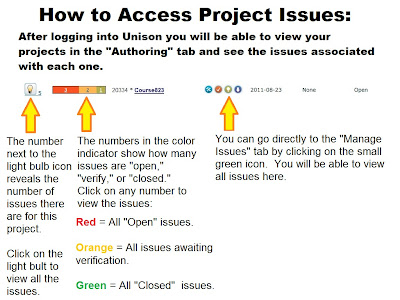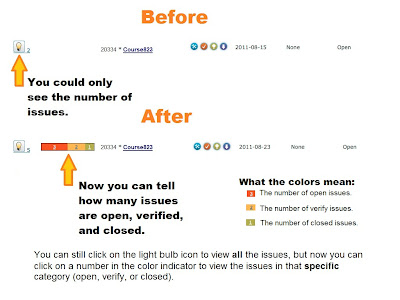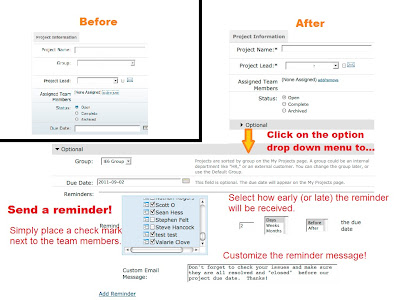Incorporating SoftSkills pages into your ProForm course is a great way to give your learners a chance to practice their skills in a simulation.
How It Works
Learners will be faced with a scenario, often with accompanying images and audio, and have to make a decision based on the options they are given. The choices that learners make will award (or deduct) points from their score and result in different subsequent scenarios and conclusions. At the end of simulation, learners can view all the choices that they made and receive feedback on each, as well as seeing the points earned for each choice and their final score.

What You Need
The SoftSkills pages run similarly to a choose-your-own-adventure book, with a scenario on each page and choices that follow and take the learner to new pages. Setting up the SoftSkills pages correctly means that the choices on each page link to another page and that each choice eventually leads to a conclusion. Every SoftSkills simulation must include the following pages:
- Start Page: Every simulation will have ONE of these pages. There are up to four choices on the start page that will link the learner to additional pages.
- Linked Pages: The amount of "linked pages" in your simulation depends on you! This is the page type that each of the four choices from the start page will go to. Every choice must lead to a "linked page" or a "last page."
- Last Pages: Any time you wish to put an end to a string of choices, a "last page" must be used. This page type will end the simulation, give the learner feedback, and allow the learner to continue on to the rest of the course.
The image below is an example of a start page.
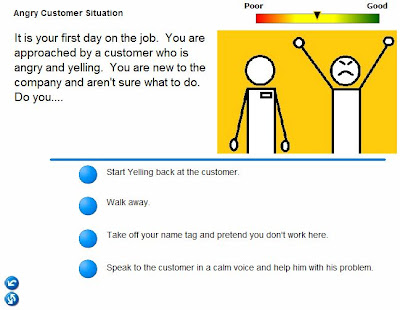
The image below is an example of a linked page. There are only two choices on this page, but you can have up to four.

The image below is an example of a last page.
 All three of these page types ("start page," "linked page," and "last page") are built off the basic SoftSkills page, but you must change the settings in a very specific way for each one. The required settings for each page type is given below:
All three of these page types ("start page," "linked page," and "last page") are built off the basic SoftSkills page, but you must change the settings in a very specific way for each one. The required settings for each page type is given below:
Start Page
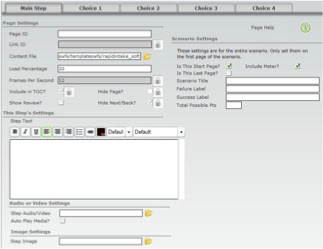 Page ID: Type in the name of the page. This is the name that will appear in the table of contents.
Page ID: Type in the name of the page. This is the name that will appear in the table of contents. Link ID: Optional. If another page links to this page, you will need to enter a link ID.
Content File: Do not change.
Load Percentage: 20
Frames per second: 12
Include in TOC?: Check this box. First click the lock, then click the box and click the lock again. This will ensure that your first page appears in the table of contents.
Show Review?: Leave this unchecked.
Hide Page?: Uncheck this box. Click the lock to open the field, click the box to uncheck it, then click the lock. This will ensure that the page is not hidden from the learner.
Hide Next/Back?: Check this box. By hiding the next and back keys, our learner won’t be able to skip over the simulation.
Step Text: Type in the text that you want the learner to read to start the scenario.
Step Audio/video: Optional. Click on the folder icon to browse for the file you want to use.
Step Image: Optional. Click on the folder icon to browse for the file you want to use.
Is This Start Page: Check this box since it is the first page of your simulation.
Is This Last Page: Leave this box unchecked.
Include Meter?: Check this box if you want your learner to see the meter that rates their responses.
Scenario Title: Type in the text that you want to appear as the heading at the top of the page during the simulation.
Failure Label: This is the text that appears on the negative side of the meter. Ex. Poor/bad
Success Label: This is the text that appears on the positive side of the meter. Ex. Great/Well Done
Total Possible Pts: The total points maximum that the learner can earn during the simulation.
Choice Tabs on the Start Page
 Each of the choices from these tabs will appear on the scenario start page, immediately below the step text.
Each of the choices from these tabs will appear on the scenario start page, immediately below the step text.
Choice n Text: The text the learner will read for this choice.
Choice n Audio: Optional. Click on the folder icon to browse for an audio file.
Choice n Point Value: Assign this choice a point value.
Choice Links To: Type in the Page ID of the "linked page" that this choice will take the learner to.
Choice n Feedback: This feedback will be received by the learner after the simulation has ended.
Linked Pages
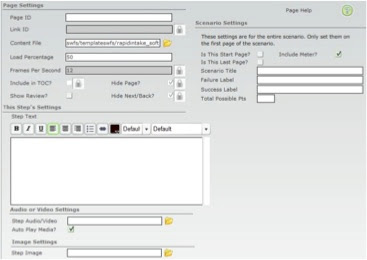
Page ID: This Page ID needs to be typed in on the corresponding choice tab that leads to this page.
Link ID: Optional.
Content File: Do not change.
Load Percentage: 50
Frames per second: 12
Include in TOC?: Uncheck this box.
Show Review?: Uncheck this box.
Hide Page?: Check this box. This will ensure that the page does not appear in the table of contents.
Hide Next/Back?: Check this box.
Step Text: Type in the text that you want the learner to read.
Step Audio/video: Optional. Click on the folder icon to browse for the file you want to use.
Step Image: Optional. Click on the folder icon to browse for the file you want to use.
Is This Start Page: Uncheck this box since it is not the first page of your simulation.
Is This Last Page: Uncheck this box since it is not the last page of your simulation.
Include Meter?: Check this box if you want your learner to see the meter that rates their responses.
Scenario Title: Leave blank.
Failure Label: Leave blank.
Success Label: Leave blank.
Total Possible Pts: Leave blank.
Choice 1-4 Tabs: Fill out up to four choice tabs that will lead your learner to even more pages.
Last Pages
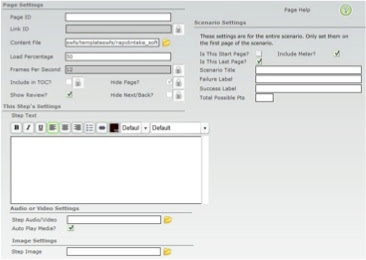
Page ID: This Page ID needs to be typed in on the corresponding choice tab that leads to this page.
Link ID: Optional.
Content File: Do not change.
Load Percentage: 50
Frames per second: 12
Include in TOC?: Uncheck this box.
Show Review?: Check this box. At this point the learner will receive a score and feedback for all the choices made during the simulation.
Hide Page?: Check this box. This will ensure that the page does not appear in the table of contents.
Hide Next/Back?: Uncheck this box. After completing the simulation, the learner will will click on the “Next” button to take them to the next part of the course.
Step Text: Type in the text that you want the learner to read.
Step Audio/video: Optional. Click on the folder icon to browse for the file you want to use.
Step Image: Optional. Click on the folder icon to browse for the file you want to use.
Is This Start Page: Uncheck this box since it is not the first page of your simulation.
Is This Last Page: Check this box since it is not the last page of your simulation.
Include Meter?: Check this box if you want your learner to see the meter that rates their responses.
Scenario Title: Leave blank.
Failure Label: Leave blank.
Success Label: Leave blank.
Total Possible Pts: Leave blank.
Choice1-4 Tabs: Leave blank.
Your simulation is now complete!



